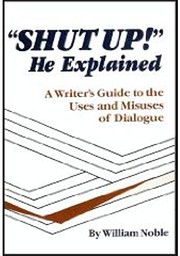

Fai clic su di un'immagine per andare a Google Ricerca Libri.
|
Sto caricando le informazioni... Shut Up! He Explained: A Writer's Guide to the Uses and Misuses of Dialoguedi William Noble
 Nessuno Sto caricando le informazioni...
Iscriviti per consentire a LibraryThing di scoprire se ti piacerà questo libro. Attualmente non vi sono conversazioni su questo libro.   ) )nessuna recensione | aggiungi una recensione
Dialogue must contribute to the telling of the story said Victorian-era novelist Anthony Trollope more than one hundred years ago and his words have been a yardstick for writers ever since. A more recent novelist, Stephen King, wrote, "When dialogue is right, we know. When it's wrong we also know-it jags on the ear like a badly tuned musical instrument." In "Shut Up " He Explained (the title comes from a Ring Lardner poke at the way some people overwrite), William Noble shows you how to write dialogue that sounds right and contributes. Fiction or Nonfiction With liberal use of anecdotes and examples, Noble develops six "Master Keys to Dialogue," each of which is crucial for the fiction or nonfiction writer to understand and use. You'll learn how to use dialogue to: - create tension - develop your characters - establish setting - move the plot - create flashbacks and transitions You'll also learn when to use narrative instead of dialogue; how to write in dialect; and how to deal with interior monologue (your character's thoughts). And more An important section of "Shut Up " He Explained covers the misuse of dialogue from the legal viewpoint, exploring libel and right-to-privacy. Get a copy of "Shut Up He Explained" an make your writing scintillate with captivating dialogue. "This is the best book that I could find on the use of dialog when writing fiction." -Amazon.com review Non sono state trovate descrizioni di biblioteche |
Discussioni correntiNessunoCopertine popolari
 Google Books — Sto caricando le informazioni... Google Books — Sto caricando le informazioni...GeneriSistema Decimale Melvil (DDC)808.02Literature By Topic Rhetoric and anthologies Rhetoric and anthologies Authorship techniques, plagiarism, editorial techniquesClassificazione LCVotoMedia: (3.8) (3.8)
Sei tu?Diventa un autore di LibraryThing. |
||||||||||||||||||||||||||||||||||||||||||||||||||||||||||||||||||||||||||||||||||||||||||||||||||||||||||||||||||||||||